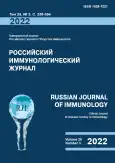Effect of mifepristone under acute stress on thymocyte apoptosis in mice
- 作者: Shilov Y.I.1,2, Shilov S.Y.1,2, Barkov S.Y.1, Shilova N.A.2
-
隶属关系:
- Institute of Ecology and Genetics of Microorganisms, Ural Branch, Russian Academy of Sciences
- E.A. Wagner Perm State Medical University
- 期: 卷 25, 编号 3 (2022)
- 页面: 345-350
- 栏目: SHORT COMMUNICATIONS
- URL: https://journals.rcsi.science/1028-7221/article/view/120224
- DOI: https://doi.org/10.46235/1028-7221-1147-EOM
- ID: 120224
如何引用文章
全文:
详细
In 1936, the Canadian pathologist Hans Selye, in experiments with adrenalectomy, has shown adrenal cortex hormones to be involved in development of thymic acute involution under stress. By 1970s, the idea of lysis of lymphoid cells by glucocorticoids dominated among researchers as the main mechanism of these changes. Later on, increased migration of T lymphocytes from thymus as well as decreased migration of bone marrow precursors to the thymus were considered. Since 1990s, apoptosis induced by glucocorticoids was also studied in this respect. To elucidate the in vivo contribution of glucocorticoids these events, a convenient tool was developed in experimental endocrinology and pharmacology, i.e., treatment of male rats or mice with antagonist of glucocorticoid and progesterone receptors mifepristone, also known as RU-38486 or RU-486. The purpose of this work is to investigate the effect of mifepristone on thymocyte apoptosis in mice under acute stress. Experimental studies were performed in male white noninbred mice. Mifepristone was injected once subcutaneously 30 min before immobilization at a dose of 50 mg/kg body weight prepared in olive oil solution. Control mice and the animals from comparison group were injected once subcutaneously with an equivalent amount of the drug solvent. A classical model of 24-hour immobilization stress in a plastic restrainer (supine position) was used for experimental simulation of acute stress. Thymocyte apoptosis was assessed by flow laser cytometry with BD PE Annexin V Apoptosis Detection Kit I (BD Pharmingen™) reagent kit adapted for Guava EasyCyte flow laser cytometer by Millipore Corporation. It was found that acute stress induced by 24-hour immobilization of mice leads to an increase in the total relative number of 7-AAD-positive cells as well as proportion of cells stained with 7-AAD, but not annexin V-PE (nuclear debris, annexin V(-), 7-AAD (+)). Administration of mifepristone alleviated these changes, thus confirming involvement of glucocorticoids in increasing number of necrotic thymocytes. The number of thymocytes in early apoptosis (i.e., annexin V-PE-positive, 7-AAD-negative), as well as total relative number of cells with phosphatidylserine exposed at the surface (annexin V-PE-positive thymocytes) under acute stress and at stress on the background of the introduction of mifepristone did not differ from the control.
关键词
作者简介
Yu. Shilov
Institute of Ecology and Genetics of Microorganisms, Ural Branch, Russian Academy of Sciences; E.A. Wagner Perm State Medical University
编辑信件的主要联系方式.
Email: jshilov@mail.ru
PhD (Medicine), Associate Professor, Senior Research Associate, Laboratory of Ecological Immunology; Associate Professor, Department of Immunology
俄罗斯联邦, Perm; PermS. Shilov
Institute of Ecology and Genetics of Microorganisms, Ural Branch, Russian Academy of Sciences; E.A. Wagner Perm State Medical University
Email: jshilov@mail.ru
PhD (Medicine), Junior Research Asociate, Laboratory of Ecological Immunology; Associate Professor, Department of Normal Physiology
俄罗斯联邦, Perm; PermS. Barkov
Institute of Ecology and Genetics of Microorganisms, Ural Branch, Russian Academy of Sciences
Email: jshilov@mail.ru
Postgraduate Student, Laboratory of Ecological Immunology
俄罗斯联邦, PermN. Shilova
E.A. Wagner Perm State Medical University
Email: jshilov@mail.ru
PhD (Medicine), Associate Professor, Department of Immunology
俄罗斯联邦, Perm参考
- Старская И.С., Полевщиков А.В. Морфологические аспекты атрофии тимуса при стрессе // Иммунология, 2013. Т. 34, № 5. С. 271-277. [Starskaya I.S., Polevshchikov A.V. Morphological aspects of atrophy of the thymus under stress. Immunologya = Immunologya, 2013, Vol. 34, no. 5, pp. 271-277. (In Russ.)]
- Alexander J.K., DeVries A.C., Kigerl K.A., Dahlman J.M., Popovich P.G. Stress exacerbates neuropathic pain via glucocorticoid and NMDA receptor activation. Brain Behav. Immun., 2009, Vol. 23, no. 6, pp. 851-860.
- Claman H.N., Moorhead J.W., Benner W.H. Corticosteroids and lymphoid cells in vitro. I. Hydrocortisone lysis of human, guinea pig, and mouse thymus cells. J. Lab. Clin. Med., 1971, Vol. 78, no. 4, pp. 499-507.
- Muscari I., Adorisio S., Liberati A.M., Thuy T.T., Van Sung T., Cannarile L., Ayroldi E., Riccardi C., Delfino D.V. Bcl-xL overexpression decreases GILZ levels and inhibits glucocorticoid-induced activation of caspase-8 and caspase-3 in mouse thymocytes. J. Transl. Autoimmun., 2020, Vol. 3, 100035. doi: 10.1016/j.jtauto.2020.100035.
- Paré W.P., Glavin G.B. Restraint stress in biomedical research: a review. Neurosci. Biobehav. Rev., 1986, Vol. 10, no. 3, pp. 339-370.
- Selye H. Thymus and adrenals in the response of the organism to injuries and intoxications. Br. J. Exp. Pathol., 1936, Vol. 17, no. 3, pp. 234-248.
- Serebriakova M.K., Kudryavtsev I.V., Balcan E., Polevshchikov A.V. The experience in lectins application to assess changes in the carbohydrate composition of murine thymocytes glycocalyx in the early and late apoptotic stages. Cell Tissue Biol., 2020, Vol. 14, no. 6, pp. 427-436.
补充文件







